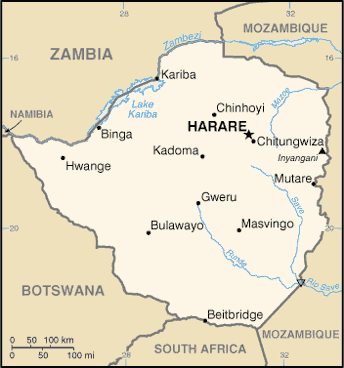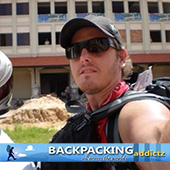- Population: 12.9 million (UN, 2005)
- Capital: Harare
- Area: 390,759 sq km (150,873 sq miles)
- Major language: English (official), Shona, Sindebele
- Major religions: Christianity, indigenous beliefs
- Life expectancy: 37 years (men), 37 years (women) (UN)
- Monetary unit: 1 Zimbabwe dollar = 100 cents
Backpacking in Zimbabwe
The Republic of Zimbabwe, formerly Southern Rhodesia, is a fair example of how distant and diverted tourism is to the actual conditions of the country. The thick green rainforests and the spectacular wildlife diversity make the country at the top of safari expeditions for travelers with the Victoria Falls adding to its allure. Mugabe makes clear that one’s personal gain is the only thing worth caring for, as well as the means of getting it, which is tourism. The tourism industry is as luxe as the First Lady, who is also known as “First Shopper” for her extravagant and rather merchandise manic behaviour, contra the existent poverty of the Zimbabwean masses that’s nowhere near sufficient. Years of savings won’t be able to afford a pair of her Ferragamos. The current safety issue only compounds the situation.
To say that Zimbabwe, which means “House of Stone,” was once the Breadbasket of Africa is no overstatement. It is true that the natural surroundings of the country are so rich and charming that it pulls even the most unrelenting visitor. With Zimbabwe’s new First Lady’s shopping bonanza, the booming and poverty-blighted Zimbabweans hope to make a living with fuel and whatever else is available in its own backyard. Hence, deforestation and poaching became insistent national issues, while the iron fist of Mugabe remains weak and irresolute as to the country’s future.
GEOGRAPHY
Zimbabwe (20 00 S, 30 00 E) is a landlocked nation of 390,757 km2 of mostly desert and savannah terrain. The country is mostly high plateau, particularly to the centre (Highveld), generally not lower than 162 m, the lowest point. To the east are Zimbabwe’s mountains, the highest being the Inyangani at a height of 2,592 m above sea level. One of the Seven Wonders of the World, the Victoria Falls, is in North Western Zimbabwe, and is claimed to be largest waterfall in the world at 1,708 m wide and 108 m tall, while neither widest nor tallest.
CLIMATE
Generally, it is a sub-/tropical climate with a rainy season from November to March. Still, the overall climate is moderated by altitude- that is reversely proportional.
PEOPLE
Zimbabweans at present are estimated at 11,651,858 of mostly African ancestry. Shona is the largest ethnic group of Zimbabwe with over 80% of the population of this ethnicity. Ndebele holds around 16% of the population of this descent. Small populaces of other African ethnic groups, Whites, Asians, and mixed ethnicities form a small minority of around 2%. The life expectancy of Zimbabweans falls at 47.55 years due to poverty, famine, and diseases with special attention due to AIDS, where 1.3 million people live with the disorder.
LANGUAGE
Zimbabwe is characterized by numerous minority languages. Correspondingly, SHONA and SINDEBELE (Bantu languages) are the principal languages of the country. ENGLISH is the official language primarily used in the urban areas, and the first language of almost 2% of the population of white and mixed ethnicities.
RELIGION
The majority abide by the Christian faith, almost 75%, where partially, some are “syncretic” or part-Christian and part-indigenous. Others are Muslim, animists, or some traditional African religious.
ATTRACTIONS
Zimbabwe is characterised by a multitude of interesting sights and sounds. The country used to be a magnet of diverse wildlife with its especially rich landscape, but much has changed due to the clashing forces of poverty and westernization, which supposedly is one without the other. Poaching, deforestation, toxic wastes and metal pollution, are irreversible and immediate outcomes of poverty and corruption that drive the local tribes to resort to utilizing what abundant resources they have to make a living, what the Mugabe now refuses to do for them. This was known to have a notorious black rhino concentration, in fact, once the largest in the world. The traveller can still enjoy the rhinos here, plus tons of other game as Zimbabwe offers among the best wildlife parks in the world, like the Mana Pools National Park on the banks of the Zambezi.
The majestic falls of Victoria is a spectacle in itself, but more is to behold from the river that gives it life. The Zambezi is powered by thousands of streams and tributaries concocting what is “the greatest single curtain of water in world”. Zimbabwe shares the Victoria Falls with Zambia, as the Zambezi River from whence the water comes falls at the border as an aquatic barrier between the two. Along with the Mana Pools National Park, here as well are Sapi and Chewore Safari Area, a triad that forms one of the 5 UNESCO World Heritage Sites in Zimbabwe, and deservingly, the park features an abounding concentration of wildlife from the Big Five to the Nile crike. Zimbabwe has more than nature and the Victoria Falls as tourism fall-back, UNESCO World Heritage Sites, one being the Matobo Hills with distinct rock formations that are nothing like anywhere in the world.
Besides trekking, game watching, and possibly hunting (controlled, of course), the Devil’s Pool is a no-miss opportunity. Undoubtedly, one of, if not the most surreal place on earth and a bizarre place to take a dip. This is a small lagoon enclosed by rocks right on the edge of the world’s supreme waterfall, the Victoria Falls, which locals call, “The Smoke that Thunders” of its image of smoke rising from the sheer power of it. It is an utterly spectacular sight, little wonder the wildlife takes a moment to gather around and watch the roaring fall and “spray and smoke” show, the huge spectacle that it is. Just don’t sit too close to the edge or do, whatever your pleasure. If only Mugabe would quit giving bad international press, tourism wouldn’t be such a hard sell.
FOOD
Famine has stricken, the economy has collapsed, but the Zimbabwean cuisine will remain and hold potential, if for the pleasure of the traveller to say the least. Meats are a special treat, even more so with the falling incomes where at present, lesser of these can be had. Maize meal or sadza, the staple,is more famous than ever and is eaten in almost every single bloody meal, again thanks to Mugabe to whom everything can be blamed for. A quintessential Zimbabwean meal would be sadza served with greens, beans, and roasted or grilled meat. The common city food fare is sandwich, which Zimbabwe does a great mighty job at. The land is rich and fertile and amazing culinary possibilities will soon be explored, after Mugabe at least. As he is one the longest-serving African rulers, that may mean quite some time. Once Africa’s breadbasket, the nation was prime in surplus agricultural exports as vegetables and cornmeal. Now, with the First Lady’s usurping farmer’s lands for her hobby, it’s rats for lunch and papaya candy for dessert.
***






Leave A Response